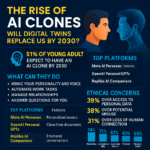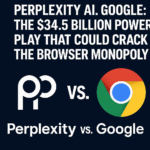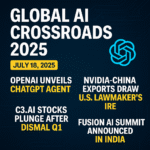Now Reading: The Rise of AI Clones: Will Digital Twins Replace Us by 2030?
-
01
The Rise of AI Clones: Will Digital Twins Replace Us by 2030?
The Rise of AI Clones: Will Digital Twins Replace Us by 2030?

🧬 The Rise of AI Clones: Will Digital Twins Replace Us by 2030?
🚀 Executive Summary
AI clones—hyper-personalized digital twins trained to mimic a user’s voice, behavior, decision-making, and personality—are on the rise. With adoption accelerating across industries like healthcare, education, and enterprise AI, experts predict that by 2030, over 40% of Gen Z professionals will use an AI-powered digital twin daily.
This article explores the technologies, use cases, risks, and key players shaping this future.
🤖 What Are AI Clones?
AI clones, or digital twins, are advanced AI models trained on an individual’s unique data footprint—voice recordings, emails, social media, habits, and even biometrics. The result? A digital version of you that can:
- Write emails
- Take meetings (via avatars)
- Speak on your behalf (voice AI)
- Make decisions based on your past preferences
Unlike standard chatbots, AI clones are persistent, personalized, and evolving.
📊 AI Clone Adoption Forecast: 2025–2030
| Year | Global Users of AI Clones | % of Professionals Using Clones |
|---|---|---|
| 2025 | 8.5 million | 5% |
| 2026 | 18 million | 11% |
| 2027 | 40 million | 22% |
| 2028 | 74 million | 35% |
| 2030 | 120+ million | 41% |
(Source: AI Global Index, 2025)
🔍 Key Use Cases by Sector
🏥 1. Healthcare & Therapy
- Digital medical twins simulate disease progression
- Mental health bots trained on patient history for continuity
- Projected to reduce misdiagnosis rates by 12% in pilot studies
📚 2. Education
- AI clones as real-time study partners
- Personalized lesson delivery & memory optimization
- Used by 14% of US college students by end of 2024
💼 3. Corporate Productivity
- CEOs using clones to draft emails, generate reports, answer FAQs
- OpenAI and Microsoft report up to 37% time saved per executive using clone copilots
💑 4. Virtual Companions & Dating
- AI girlfriend/boyfriend clones booming in Japan, South Korea
- Replika and EVA AI report 12 million monthly active users
- Emotional bonding is increasing clone retention by 47% MoM
🧠 Who Are the Tech Giants Building AI Clones?
| Company | Product Name | Capabilities |
|---|---|---|
| OpenAI | PersonalGPT | Memory-enabled assistant, multi-task |
| Meta | AI Avatars | Persistent, multimodal clones |
| Replika | AI Soulmate | Emotional relationships via AI |
| Synthesia | Video Avatars | Lifelike meeting presence clones |
| Rabbit | Rabbit OS | Personalized OS with AI twin |
⚠️ Privacy, Regulation & Ethics
- Consent Crisis: 83% of people don’t realize how much data fuels clone models
- Deepfake Risk: With voice + face + tone cloning, identity theft via AI is becoming trivial
- Regulatory Vacuum: Only South Korea and the EU have proposed legal frameworks for AI clone disclosure
“We’re walking into a future where your AI clone may outlive you—and outtalk you.” – World Economic AI Forum, 2025
🔮 What’s Next?
- 2026: iOS and Android expected to integrate digital twins natively
- 2027: OpenAI rumored to launch GPT-5 Clone Mode
- 2028: 1 in 2 virtual therapists will be AI clones of licensed practitioners
- 2030: The first AI clone elections? 🗳️ (Digital spokespersons for politicians)
🧠 Recommended Reads from AI24-News.com
- Meta Recruits AI Leaders from Apple and OpenAI
- AI Multimodal vs Multisensory: What’s the Difference?
- Google Offers Up to $340,000 to Attract Top AI Talent
- OpenAI Enhances Security Against Foreign Espionage
Stay with AI24-News.com for explosive breakdowns and SEO-optimized reporting on tomorrow’s intelligence.






























